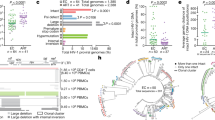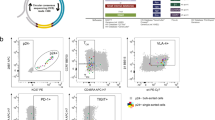Abstract
Treatment of HIV-1-infected individuals with a combination of anti-retroviral agents results in sustained suppression of HIV-1 replication, as evidenced by a reduction in plasma viral RNA to levels below the limit of detection of available assays1,2. However, even in patients whose plasma viral RNA levels have been suppressed to below detectable levels for up to 30 months, replication-competent virus can routinely be recovered from patient peripheral blood mononuclear cells3,4 and from semen5. A reservoir of latently infected cells established early in infection6 may be involved in the maintenance of viral persistence despite highly active anti-retroviral therapy3,4,5. However, whether virus replication persists in such patients is unknown. HIV-1 cDNA episomes are labile products of virus infection and indicative of recent infection events. Using episome-specific PCR, we demonstrate here ongoing virus replication in a large percentage of infected individuals on highly active anti-retroviral therapy, despite sustained undetectable levels of plasma viral RNA. The presence of a reservoir of ‘covert’ virus replication in patients on highly active anti-retroviral therapy has important implications for the clinical management of HIV-1-infected individuals and for the development of virus eradication strategies.
This is a preview of subscription content, access via your institution
Access options
Subscribe to this journal
Receive 12 print issues and online access
$209.00 per year
only $17.42 per issue
Buy this article
- Purchase on Springer Link
- Instant access to full article PDF
Prices may be subject to local taxes which are calculated during checkout




Similar content being viewed by others
References
Perelson, A.S., Neumann, A.U., Markowtiz, M., Leonard, J.M. & Ho, D.D. HIV-1 dynamics in vivo: virion clearance rate, infected cell life-span, and viral generation time. Science 271, 1582–1586 ( 1996).
Gulick, R.M. et al. Treatment with indinavir, zidovudine, and lamivudine in adults with human immunodeficiency virus infection and prior antiretroviral therapy . N. Engl. J. Med. 337, 734– 739 (1997).
Wong, J.K. et al. Recovery of replication-competent HIV despite prolonged suppression of plasma viremia. Science 278, 1291– 1227 (1997).
Finzi, D., et al. Identification of a reservoir for HIV-1 in patients on highly active antiretroviral therapy. Science 278, 1295–1300 (1997).
Zhang, H., et al. Human immunodeficiency virus type 1 in the semen of men receiving highly active antiretroviral therapy. N. Engl. J. Med. 339, 1803–1809 (1998).
Chun, T.W. et al. Early establishment of a pool of latently infected, resting CD4(+) T cells during primary HIV-1 infection. Proc. Natl. Acad. Sci. USA 95, 8869–8873 ( 1998).
Stevenson, M., et al. Integration is not necessary for expression of human immunodeficiency virus type 1 protein products. J. Virol. 64, 2421–2425 (1990).
Zhang, L., et al. Rapid clearance of simian immunodeficiency virus particles from plasma of rhesus macaques. J. Virol. 73, 855–860 (1999).
Zhang, L., et al. Quantifying residual HIV-1 replication in patients receiving combination antiretroviral therapy. N. Engl. J. Med. 340, 1605–1613 (1999).
Furtado, M.R. et al. Persistence of HIV-1 transcription in peripheral blood mononuclear cells in patients receiving potent antiretroviral therapy. N. Engl. J. Med. 340, 1614–1622 ( 1999).
Brown, P.O., Bowerman, B., Varmus, H.E. & Bishop, J.M. Correct integration of retroviral DNA in vitro. Cell 49, 347–356 (1987).
Bukrinsky, M.I., Stanwick, T.L., Dempsey, M.P. & Stevenson, M. Quiescent T lymphocytes as an inducible virus reservoir in HIV-1 infection . Science 254, 423–427 (1991).
Zack, J.A., et al. HIV-1 entry into quiescent primary lymphocytes: molecular analysis reveals a labile, latent viral structure. Cell 61, 213–222 (1990).
Stevenson, M., Stanwick, T.L., Dempsey, M.P. & Lamonica, C.A. HIV-1 replication is controlled at the level of T cell activation and proviral integration. EMBO J. 9, 1551– 1560 (1990).
Sonza, S., et al. Human immunodeficiency virus type 1 replication is blocked prior to reverse transcription and integration in freshly isolated peripheral blood monocytes. J. Virol. 70, 3863– 3869 (1996).
Livingstone, W.J., Moore, M., Innes, D., Bell, J.E. & Simmonds, P. Frequent infection of peripheral blood CD8-positive T-lymphocytes with HIV-1. Edinburgh Heterosexual Transmission Study Group . Lancet 348, 649–654 (1996).
Chun, T.W. et al. Quantification of latent tissue reservoirs and total body viral load in HIV-1 infection. Nature 387, 183–188 (1997).
Spina, C.A., Prince, H.E. & Richman, D.D. Preferential replication of HIV-1 in the CD45RO memory cell subset of primary CD4 lymphocytes in vitro. J. Clin. Invest. 99, 1774–1785 ( 1997).
Riley, J.L., et al. Naive and memory CD4 T cells differ in their susceptibilities to human immunodeficiency virus type 1 infection following CD28 costimulation: implications for transmission and pathogenesis. J. Virol. 72, 8273–8280 (1998).
Finzi, D., et al. Latent infection of CD4+ T cells provides a mechanism for lifelong persistence of HIV-1, even in patients on effective combination therapy. Nature Med. 5, 512– 517 (1999).
Cowan, N.J., Dobner, P.R., Fuchs, E.V. & Cleveland, D.W., Expression of human alpha-tubulin genes: interspecies conservation of 3′ untranslated regions. Mol. Cell. Biol. 3, 1738–1745 (1983).
Acknowledgements
We thank P. Himlan, L. Mangini, C. Jaffarian, B. Cullen and L. O'Reilly for patient recruitment and scheduling; M. McManus for data management; C. Waterworth and G. Sontag of Imperial College and research associates in the laboratory of pediatric immunology at UMass Medical School for technical assistance; N. Bakker for manuscript preparation; and B. Mellor for assistance in preparation of the figures. Jurkat-CCR5 cells were obtained from M. Emerman. This work was supported in part by National Institutes of Health grants RR11589, HL57880 (M.S.) AI 32391 (K.L.), and AI32907 (J.L.S.). M. Sharkey is the recipient of a National Institutes of Health training grant (T32 AI07272). K. Luzuriaga is an Elizabeth Glaser Scientist of the Elizabeth Glaser Pediatric AIDS Foundation.
Author information
Authors and Affiliations
Corresponding author
Rights and permissions
About this article
Cite this article
Sharkey, M., Teo, I., Greenough, T. et al. Persistence of episomal HIV-1 infection intermediates in patients on highly active anti-retroviral therapy. Nat Med 6, 76–81 (2000). https://doi.org/10.1038/71569
Issue Date:
DOI: https://doi.org/10.1038/71569
This article is cited by
-
HIV Reservoir: How to Measure It?
Current HIV/AIDS Reports (2023)
-
External quality assessment of HIV-1 DNA quantification assays used in the clinical setting in Italy
Scientific Reports (2022)
-
A comparative analysis of unintegrated HIV-1 DNA measurement as a potential biomarker of the cellular reservoir in the blood of patients controlling and non-controlling viral replication
Journal of Translational Medicine (2020)
-
Prolonged administration of maraviroc reactivates latent HIV in vivo but it does not prevent antiretroviral-free viral rebound
Scientific Reports (2020)
-
Psychosocial Correlates of Monocyte Activation and HIV Persistence in Methamphetamine Users
Journal of Neuroimmune Pharmacology (2019)



